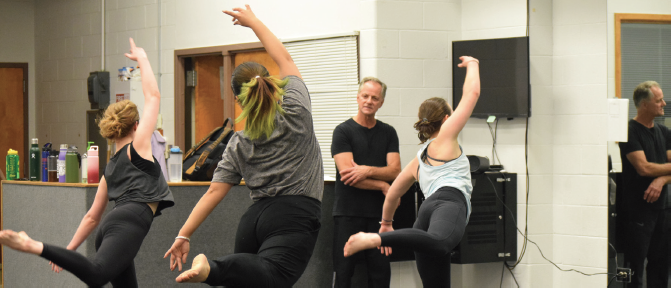
Megan Tuennerman
A&E Editor
Today’s discussions of migration have become politically charged and considerations of humanity — thinking deeply about what connects us to, and makes us different from, each other as a species — are crucial. A group of professors and students here at Wooster decided to focus on what makes us similar and to demonstrate their thoughts through a performance titled “Migration and Dance: An Interdisciplinary Kinetic Learning Experience.” The performance will be held in McGaw Chapel on Saturday, Sep. 14 at 11:00 a.m and is free and open to the public.
The program involves Professors Mareike Herrman, Niklas Manz, Amyaz Moledina, Laura Sirot and Kim Tritt as they collaborate with world-renowned choreographer Peter Pucci. The basis of this performance is another work by Pucci that was simply titled “Migration,” and was based off of the book and film “Journey of Man” written by Spencer Wells. Pucci said that he first heard an interview on NPR around the time he was looking to create a large work that brought dancers of different areas together. The interview described how Wells’ research found that all our DNA is connected, and can be traced back to the same group of people. From that idea came the piece “Migration” that was performed in Pucci’s hometown of Baltimore, Md and consisted of roughly 50 dancers for a one-time-only production that drew a crowd of around 1,000.
The origins of bringing the project to Wooster stem from a faculty college that brought together 28 faculty members from different schools with a focus on the issue of Mobility and Migration. Attendees Professors Moledina, Sirot and Tritt began to explore ways in which the arts and sciences could collaborate with a focus on art. According to Moledina, “the power of the arts to imagine a world that is different was underleveraged … More than ‘minds’ coming together, ‘our collective bodies’ needed to come together.” Sirot knew of Pucci’s previous work and felt that because it was largely based off of genetics, it would be the perfect answer to their question of collaboration between arts and sciences.
After discussions with Pucci about the Baltimore performance, it was decided that a more modest — but also truly Wooster — experience was needed. His work at Wooster will draw students (mostly non-dancers) from classes taught by those involved. According to Tritt, those classes ended up being “the First Year Seminar classes of Mareike Herrmann and Nikklas Manz, and a volunteer group of students and faculty. Mr. Pucci is also working with Kim Tritt’s students from her choreography course who are also gaining an invaluable experience by serving as his teaching assistants.” This is a crucial component of the work because it is truly bringing together many different people into the performance. “We are working with people who may be scientists or mathematicians, but it doesn’t matter their origin as we are cross-pollinating all these unique groups of people together,” said Pucci.
Another change from Pucci’s original “Migration” is that he is not truly “choreographing” the work, instead he is acting more as a mentor.
“I am watching them as they create their own phrases through natural movement, then I separate them into specific groups (4 – 5 people) and let them create their own migration piece,” commented Pucci.
This performance speaks to the core values of Wooster: bringing independent people and their talents together to create something unique. The theme of this work is that while we are all different in our interests, cultures, skills, we are all, at our DNA base, humans. The collaborative project has been made possible by The President’s Office, using funds from the Andrew W. Mellon Foundation Grant.
